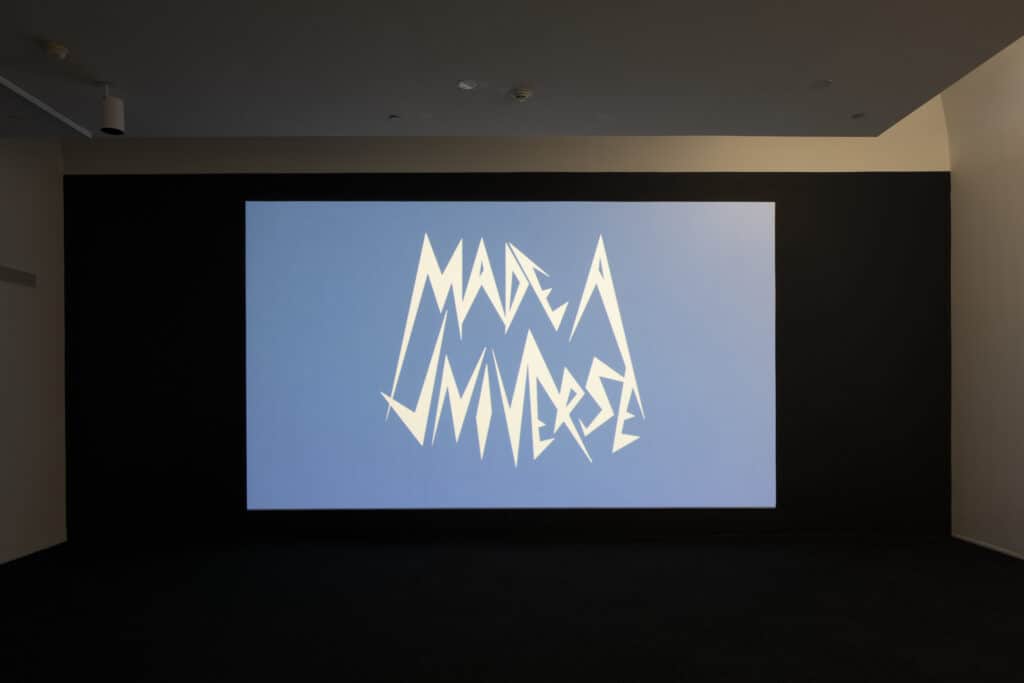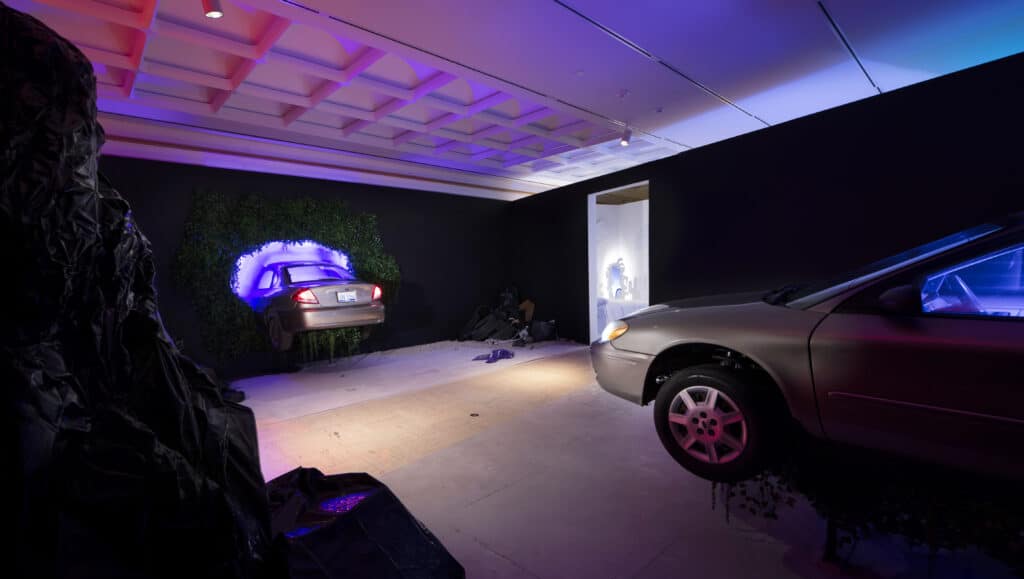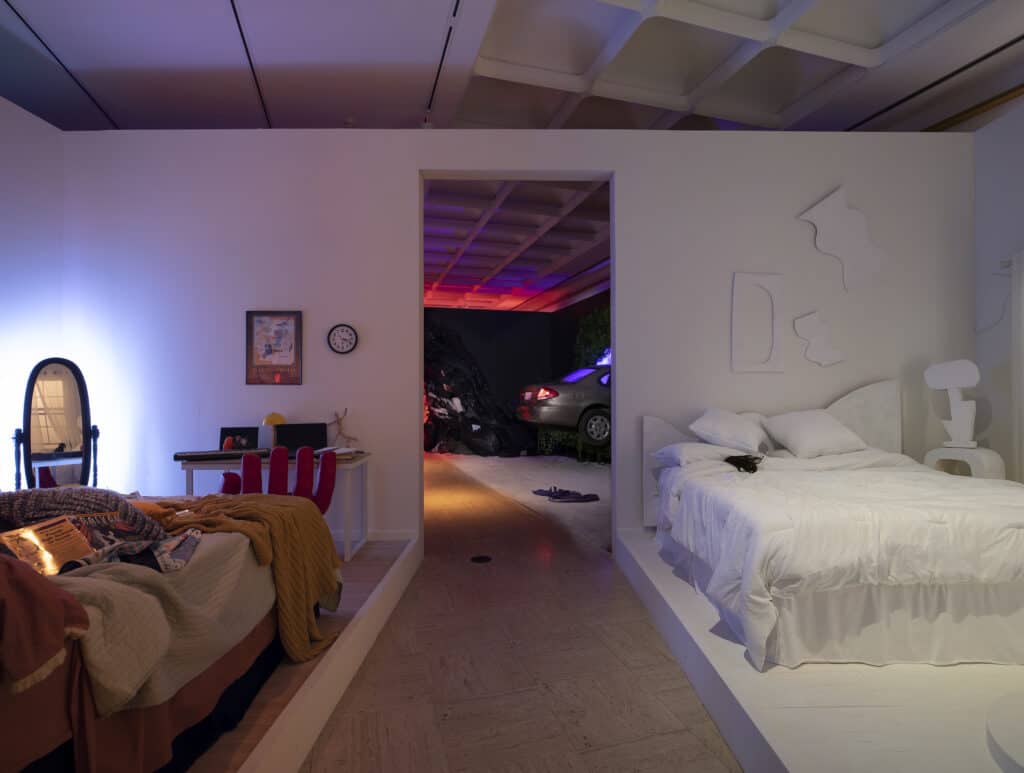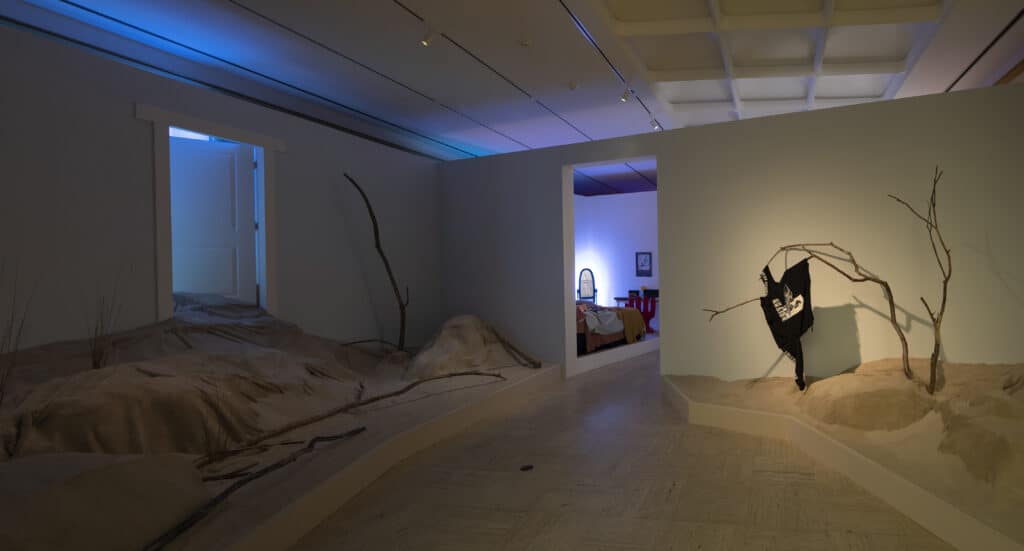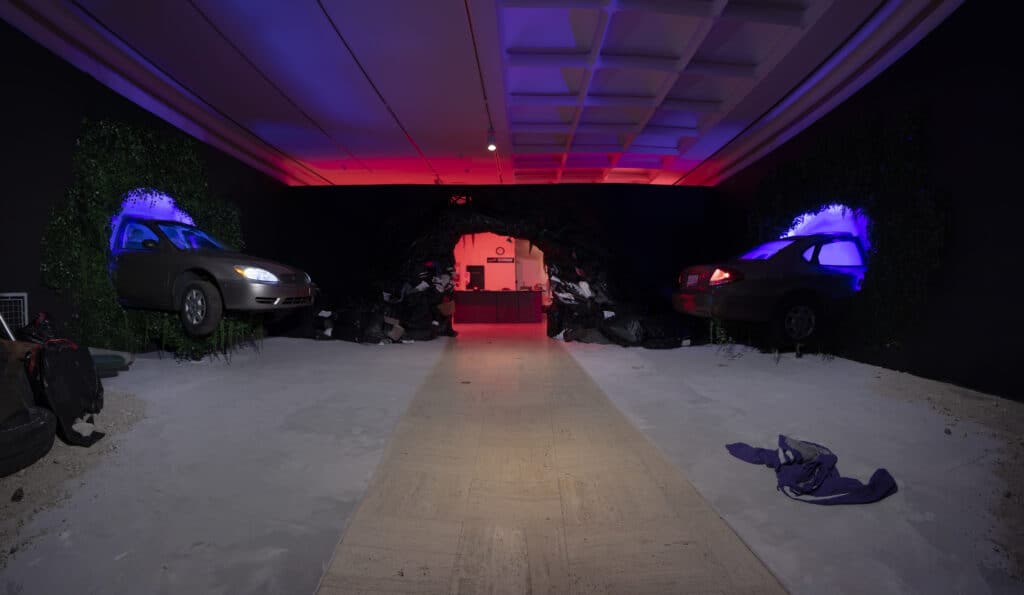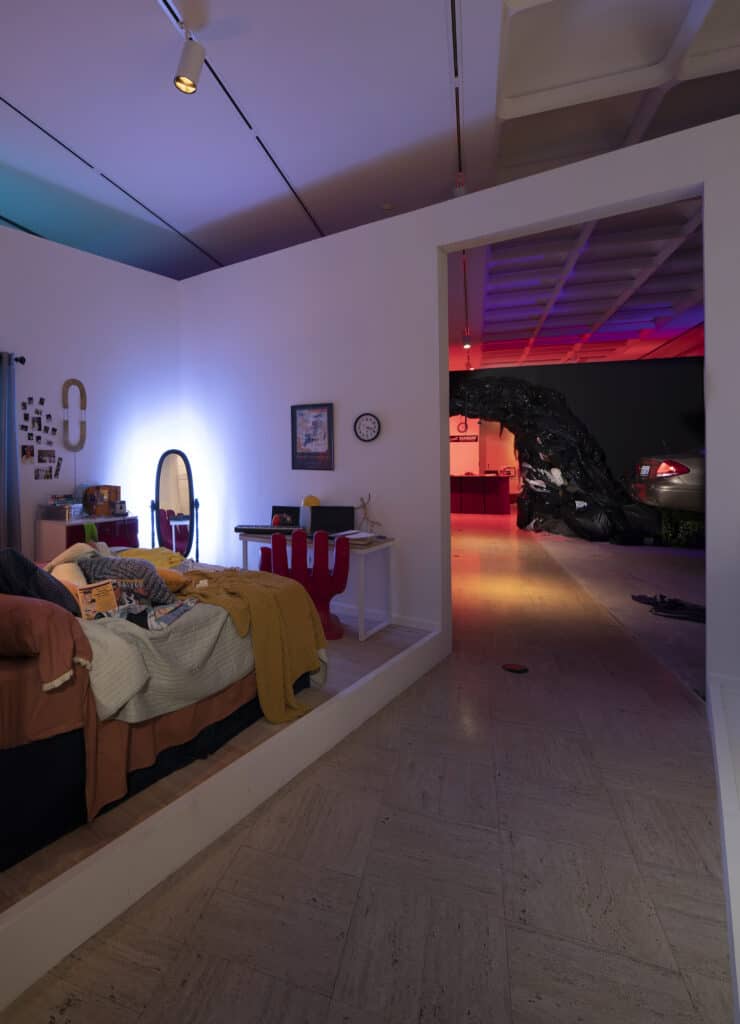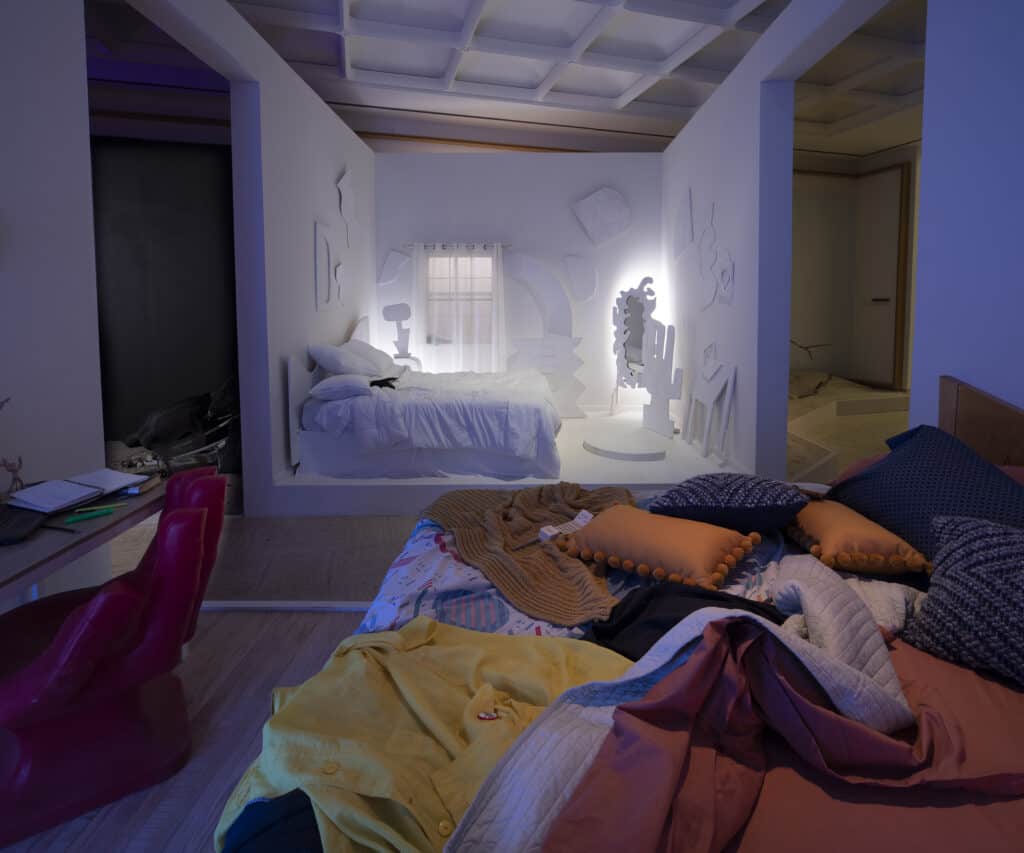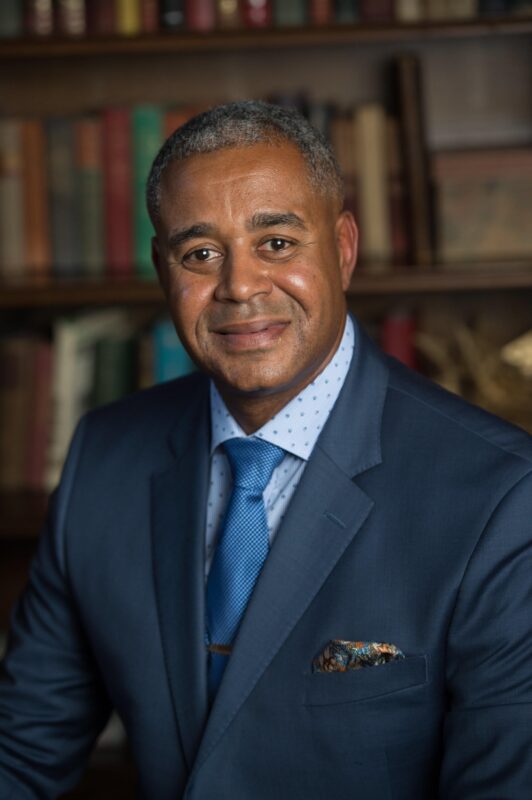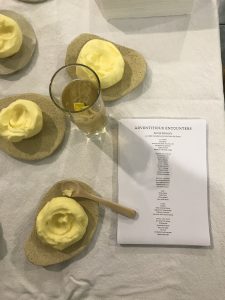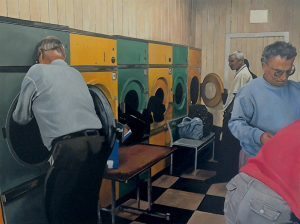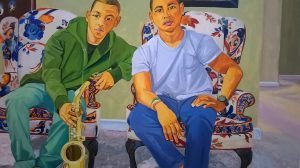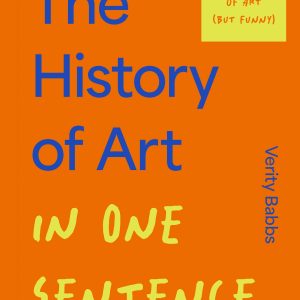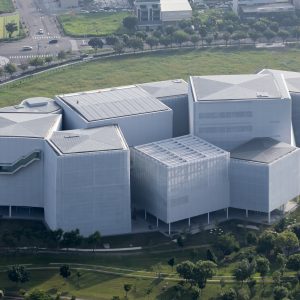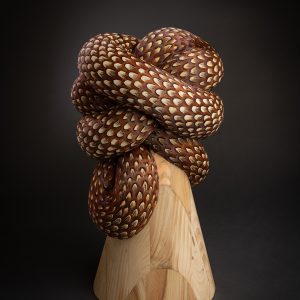Cranbrook Art Museum will present Tunde Olaniran: Made a Universe, the first film commissioned by the museum and its first project to traverse the spaces of the recording studio, the silver screen, and the gallery. The accompanying exhibition will runs through September 25th, 2022.
Tunde Olaniran (they/them) is a musician, singer, and performer based in Flint, Michigan. Starting in 2019, Cranbrook Art Museum partnered with the artist to help create the short film Made a Universe, which completed production in 2021 and will premiere as part of the exhibition at Cranbrook Art Museum.
Shot on location in Detroit and Harbor Beach, Michigan, with an entirely local cast and crew, the multimedia production explores themes of agency, liminality, human connection, and psychic and emotional power. It was directed and scored by Olaniran and features collaborations across artistic mediums with several multidisciplinary, award-winning artists, including Yo-Yo Ma.
“Tunde is a creative force of nature. They address complicated themes deeply rooted in our humanity through an otherworldly talent, their stage performances include music, choreography, and handmade costumes, and we have metaphorically turned up the volume to full blast with this multi-faceted project. It has been thrilling to collaborate on a film from scratch and to adapt an exhibition format to meet Tunde’s vision.”
said Laura Mott, Chief Curator, Cranbrook Art Museum.
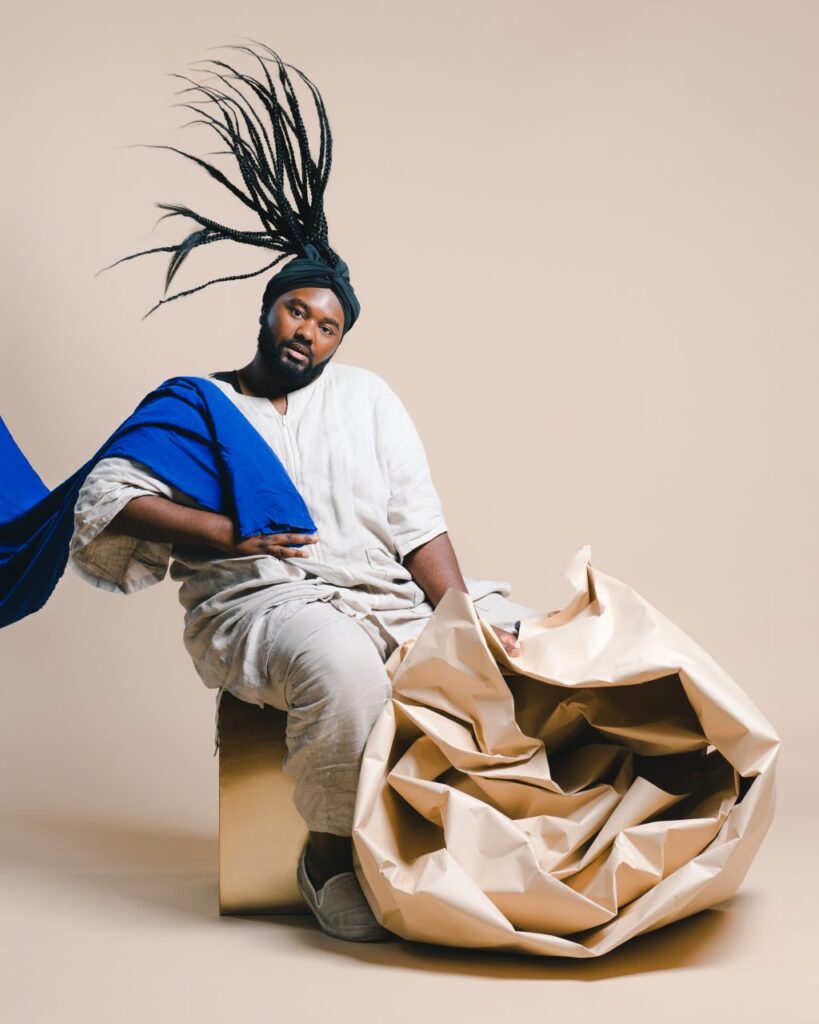
I managed to catch some time with Tunde (despite them having a bout of covid) in the world of Zoom to talk about the background to Made a Universe the film itself, the exhibition and plans for the future.
Mark Westall: Tunde how are you feeling?
Tunde Olaniran: I’m doing better. Just kind of having this kind of, I don’t know, COVID just has an interesting effect. I was just telling- this is my first time getting it. I was pretty successful in dodging it for the past two years, but the trip to New York kind of felt like it was an inevitable result.
Well, it’s pretty amazing you made a film with lots of people and didn’t get it.
We’d gotten the vaccine out, but we were pretty strict and I was really proud of us not having– At least no one reported any COVID infections on set. I was really proud of that.
I watched the film (Made a Universe) It’s about fear? And a lot of the fear seems to be about being poor or not paying bills which is really topical, because all the prices are going up now. Is that something you experienced when you were younger?
Yes. I grew up poor, working class. I think it’s interesting because at least– I don’t know where you live now. My grandmother lived in Holloway in one of those big tenements. I spent time there. It was interesting being in a place in London that’s still experiencing poverty and thinking, “This is not so different from Flint. It’s just maybe a bit more diverse.”
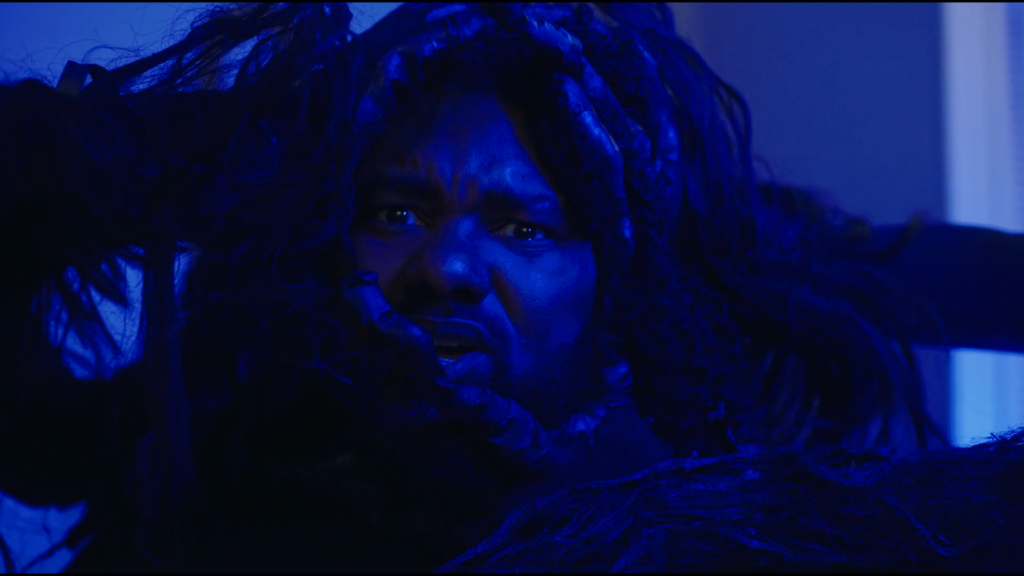
Living in the US, there’s really not a social safety net. Even if you are “well off,” it doesn’t take much to reverse your fortunes even today and that’s just always been the case. Someone at the screening who I think just kind of came to the screening was like, “I hope that now that you’re in this place you won’t have problems with bills anymore.” I was just like, “I got news for you. If you live in this country, we all have that issue even if we feel comfortable today, you don’t know what your fate could bring.”
I think there’s an anxiety that fuels people of multiple classes here, whether you are poor or not, and that’s by design. It’s about bills, it’s about being poor, but I think it’s also about the kind of emotional and physical state that puts you in, the anxiety and the tension. Like you can never really feel safe or secure. You kind of feel like–
I could give an example. A very common example is water. Growing up, if you were juggling bills and you had to pay something and then couldn’t pay fully on the other thing because you just didn’t have enough money to pay for bills, you would kind of cross your fingers because you never really knew what the timetable was for shutoff all the time. You would just roll the dice and hope that, hopefully, if I paid the bill by Friday, they won’t shut it off on Wednesday. You would wake up and your water wouldn’t be on, and maybe you would see the person who turned it off, driving away and you’d like, try to chase them down and try to see if they would come back….
They just work for the state. They’re a working-class person too, but you have 30 people you encounter. You’re like, “Hey, can you wait? I can get the money out, figure it out.” They can’t do anything, but they say, “Oh, well, if you can hurry up and pay what you can, I’m doing more shutoffs. I’ll be back around the block. I might be able to come and put it back on.” You go downtown to pay the bill. You see what the payment amount is, you pay it, then they say, “Oh, well you missed the window to get a shut back on. In three days, we can put it back on.”
All this is happening at nine in the morning when you’re supposed to be going to school or to work. It’s just one thing, but those things add up. There are studies that show it is very traumatic, changes your brain chemistry and changes so much about your health. It really affects you deeply and traumatizes you deeply and you go through this constantly.
But I think the other part of it is, we also have this weird thing where, especially in the Midwest, but I think in America it’s like being nice is more important than being good or fine or whatever. No one’s mean [laughs] Everyone’s nice and polite so it feels very surreal to be dealing with a very quiet cruel state. I mean the state is very cruel.
In Europe, people are amazed by the fact that Americans make such a fuss over free healthcare for poor people. It’s really hard for people here to understand that so many Americans are so angry about that.
I tell my cousins who live in the UK, some of them are on the fence or lean conservative and do not fall for anyone that wants to do anything to touch the NHS. Like you don’t understand how blessed you are to have that. I think that there’s a global effort to strip back that social support for working people. I think the film was a way to use media formats that I love. Like I love horror, Thriller. I love comic characters, comic stories to tell to talk about these kinds of experiences because they do feel terrifying, but they also are very surreal sometimes. That was the approach.
Back to what you said about everyone’s quite polite. It’s very–
The culture here is that you’re responsible for this systemic issue. I mean, it’s insane to think of living through the water crisis in Flint, just that, the idea that something so simple as water. Okay, here, this is the definition of so surreal and insane. During the water crisis, we couldn’t drink the water. People were being poisoned by it, people were getting rashes from it but then just still getting a bill and the water is giving you rashes or your hair is getting thinner, it was just so wild, crazy. Then Nestlé who has this license to pump our fresh water for almost nothing, donating bottles of Nestlé water to charity in Flint.
Back to the film, it’s positive, there’s a positive– You’ve got the key to the door, and you lead people out the door away from the fear. Then there’s this image of the door as well.
I don’t know if I lead people. Again, it’s like once it’s out in the world and people watch it, the meaning obviously changes and all the meaning people get from it, I think is valid in some respects. I think the intent was definitely that this character has this power that through the film, they start to learn that they have it and that they can use it to find a way out of this experience. The character doesn’t drag anyone through the door, anyone can come through the door on their own.
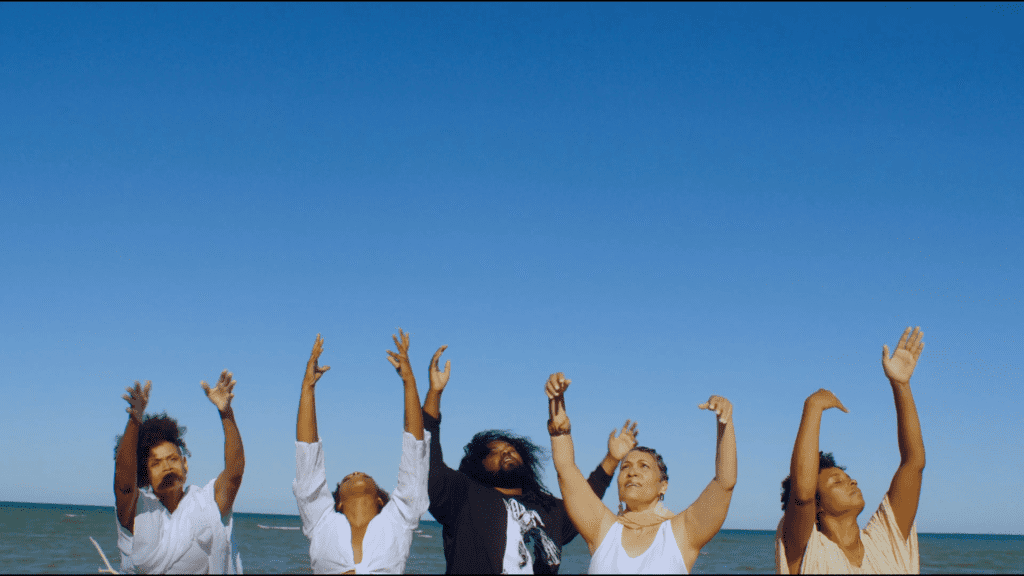
I also like that the group of women, they come through the door but they also help each other, the ones who need help. There’s this beautiful embrace and I didn’t want it to be a very clear line of like they’re completely helpless, or I’m holding their arm over the cliff or anything like that. It’s like, the door is just there.
Also, I fell through it as well. It’s like there’s no one single point of power and decision-making in changing our collective reality and our collective experience. I think visually we wanted it to look like that too. I think the door itself as the image–
It’s so funny, like, the song in that last chapter, the song I wrote with Yo-Yo Ma, he had never written a song before. He is this artist who does classics and folk standards, et cetera. When they asked, they were like, “Do you want to get in the studio with Yo-Yo?” I was like, “I’m not expecting to sing or anything, but can we just have a conversation about whatever? I just want to know about him as a person and what message would you feel you could have authorship of.” He’s the kind of person where, I think he’s literally said, “I don’t hear no anymore, doors open for me.”

I think he’s at a point in his life and career where he’s trying to figure out what to do with his voice, I think still, but in a very basic way. He just like, “I want to make sure [laughs] the doors that are open for me don’t close behind me.” He’s like, “Hey, this is my mindset.” He has also described all these other really interesting experiences and all this imagery stuck in my head, but I think the idea of a doorway is obviously influenced by the name of the song (Doorway). Then that imagery stuck with me. I think when we were writing when I was writing the script and thinking about the last scenes. Like, “Oh, a door.” What a beautiful way to end. It was just a really cool way to honour and reference that conversation with him and the influence behind the song itself.
It reminded me of a painting by René Magritte called La Victoire, which is basically a door on a beach. I think the victory is to walk through the door.
Yes. I’ve never seen this before. [laughs] That’s crazy. That’s a beautiful painting. That’s, wow.
I think what you said about it’s the fear, but I think it’s also the confusion of coming up against rules, this deep web of conditional bureaucratic rules to keep you off balance. Then also being in that bill payment centre, we just did a screening in Flint and some of the people were so scared because that really looked– They’re like, “You got a water book.” No, the art department made a great replica but sitting in those places, you rarely have conversations or you rarely glance at the people next to you. I think part of that, part of the film was, what if that wasn’t the case? Or what power or what different outcomes can happen if we were to have more of a connection? I think that is really dangerous for a capital state if individuals are moved more collectively.
Was there a person or a moment that helped you open your eyes or feel less scared or whatever, less fearful?
I think I am really lucky in that, my mother is someone who is– not only herself is a very– she takes a very macro-historical view of how economies work and just always helped me keep perspective in life and really what’s happening in life. Kept me from, I think even though we were experiencing poverty, just gave me a really interesting, a really helpful perspective, on everything.
Also, she intentionally is someone who makes family everywhere and anywhere she goes. There was always this network of people. I’m quite introverted but she always just helped me have this network of people in my life that were so supportive. I think that really creates a lifeline. Just not feeling alone is one of the ways that you survive living in this country. Then I think communities of color who do really well in this country- That’s a big part.
Then I just have these– I call them aunties, whether it’s by blood or not, who were also very revolutionary. Just being in those spaces and hearing how people who are working in the shop, they’re working-class people who have a sense of ownership of the course of their lives. Not even ownership but we understand that we do have power collectively as working people. It just gives you a different feeling.
It doesn’t make those anxieties completely disappear, it doesn’t change your material reality, but I have to say those people– I try to represent them in some ways in the women in that call centre, and thinking about specific individuals that influenced me, my mother, some of these aunts, family figures. I don’t know if that makes sense …
Yes sure complete sense
I suppose when you did the film and you had your own little family, that people came and had– Because films are made, like– They become this thing, don’t they?
It was a pretty big undertaking. I had done music videos just as an artist and typically a very small crew just three to eight people, maybe on location, on a set. Going into something like this, where it was a bit more ambitious, this director, she’s actually British, Margot Bowman who had done something in Detroit, I was a part of, and I was like, “Hey, I have this big project. I don’t know where to start.” She’s like, “You need to just find a producer, that’s your first step.”
I found this woman, Paige Wood, who is from Detroit, who has become a really good friend and she helped build a whole crew. I think she built this great ecosystem of leadership being not white men, which as an artist, it’s not good or bad, just might be the experience for an artist. Let’s say you’re an artist of color or you’re a woman. Typically, there’s a white man who owns that production. It’s either the producer or the director or who runs sound or is the promoter, there’s usually a white man who has the equipment, or has the light, has that. Your relationship with them can dictate how well their production goes.
Again, it’s not good or bad, but it’s just how it’s always been. It was really interesting being in a production where that wasn’t the case. She really made it– Safe isn’t quite the right word, but just very intentional. Oftentimes when you do a production, people are walking around, you don’t know everyone and she was like, “We’re going to have an all call and everyone sits down,” and she was like, “If you don’t know someone’s name, don’t just walk by them. Reintroduce yourself. It’s okay if you forget, but it’s your responsibility to like–“
It’s just certain things that don’t always happen in those environments that made it just– I was already having breakdowns trying to get this production together during COVID, but I could have really had a breakdown if I didn’t have someone like her who I really trust and felt very safe with.
That’s someone who I think is an amazing friend now. It makes a difference when people care about the process of a production too. I was just telling Lily, no one got COVID on set. We were really intentional about that. I was just out of production and I got COVID. It was like, wow, the difference. [chuckles] If you make it a point to care for the well-being of people, the results are different, then also the process. It’s because you care about their process, not the end result.
Can you explain a bit more about the accompanying exhibition?
Yes, so we tried to– I think the approach I wanted to take was everywhere you look is potential like a portal into a different dimension. I wanted it to feel like you have this potential to have the power of the main character, to create your own portal. That was just the idea of very simple vignettes that every time you round the corner, there’s like a completely different palette and lighting and setting. You walk through it to see the film, and then when you come back out, all of these objects have become– they have way more meaning.
The other interesting part about this film is that all these different artists that we collaborated with to build these pieces have completely different histories and backgrounds, and so talking about the story with them led to some really interesting visual things that I wouldn’t have created on my own. One example is the end of the film when I’m facing the antagonist in his home, a more ghoulish version of himself.
The artist Natasha Beste, we talked about what would be like the final– what’s scary for her, what would be scary. That wasn’t like a traditional monster in like an alien egg trying to eat you, like what’s something scary. So for her, she’s always lived in one place, but she had different trauma and part of her history has hoarding as her family history. She does installations in her art practice and they’re like symbolic environments.
She wanted to incorporate these personal found objects, which I think for her, it was like hoarding and holding onto new ideas or old ideas and never evolving or changing was like really scary to her because that was what hoarding represented, and that she was trying to escape in her family life and her history. Her relationship to objects is very different from mine. I had no objects to hold onto. That was never a problem. It’s just interesting, what’s horrifying for you in terms of your relationship to things? It’s an example of how one conversation with a fellow artist influenced that one set piece.
Do you feel that after this, or actually even in your practice, that collaboration is really important to you, to the work you produce?
Yes. Collaboration is important. The reason is, collaboration is how I operate. I think part of my goal as an artist is to show how collaboration can work, because there’s just– I don’t know, like being in a State a place like Michigan, I can’t speak for like– I’ve worked a bit in, not London, in LA, I’ve worked a little bit New York, but more in LA, there’s more happening. I think in Michigan, people are very isolated, and so you don’t always get a chance to learn how to collaborate, I guess I would say. A lot of harm gets done because of that.
I’m not saying that LA is an example of healthy collaboration, but we just don’t get to do it as much here. I’m always like, it’s important to me that I’m inviting collaborators that I especially I think are really talented, but are not always the favourite names that get pulled out of the hat when someone’s got money to spend on something, that’s very common here. There’s just a list of 10 names that everyone just like, let’s use this person for whatever.
With all the artists, I was like, what are you curious about doing but maybe you’ve been afraid of trying? Natasha is a video artist, she’s done some installation work, but hadn’t really done as much of it as she would’ve liked, and so it could’ve been very easy for me to say, “Hey, let’s collaborate, and can you be like DP on this film because that’s your main– whatever? But I know that in your heart installation work is very healing for you, and you have something to say. I’d love to invite you to do that.”
Because for me, the people that I am most appreciative of are the ones who asked me to do shit that I would never think to do, but they saw that I could. I’m just trying to keep that going, keep that practice going, because I don’t know something about it is so thrilling, and trying something new and scary, but just that I know they’ll be brilliant at.
It seems to be much more prevalent now, people having a music career and an art career, and then mixing and matching them, especially compared to, 10- years ago. Do you think there’s going to be more and more of that, where people mix and match and merge and play around with different creative disciplines, and are not worried about pigeonholes and focusing, and all that kind of stuff?
I don’t know. I’m not sure. I’m not sure if that’s going to be a trend, but it’s how I work. But I don’t think you can make it happen in an artificial way. I think a lot of brands try to have this artificial thing where they get an artist, and we’re creating a new innovative experience, and it’s like, “Okay, you’re trying to sell sunglasses, I get it. Like VR. Cool, great.”
I think you see that happening a lot, but as far as in an authentic way, I think the path– I think people are already doing it, so I can only speak for myself. A few years ago, I was just getting tired of bumping up against the edges of my practice, and feeling like, “Ugh, this part is working and I’m having a great time.” I’m feeling like I’m saying something that feels right for me, but I want to push the boundaries of like, how big of a world you can make in one statement.
I think that’s where the chief curator at Cranbrook and I were trying to think of the name of the exhibition. I was like, “What about Maybe Universe?” It’s like one of the songs, and she’s like, “That’s perfect.” Because this is a very expensive idea.
Back when I had an album coming out, this is like in 2018, this artist, she’s a writer, I think, her name is Adrienne Maree Brown. She’s one of those people who I met in Detroit who is so brilliant, and she’s one of those people who asked me to do shit that I was scared to do. [laughs] I’m so grateful for her. She’s like, “Let’s do your tarot” I remember she said, “You’re going to take this, your strange ways of being, and make a world that works for you.”
I think it’s this necessity because it feels– What? I don’t know how to put it. It’s like a way to survive and stay sane. Because I think if I had to only make music, I would have to compromise or be okay with other aspects of it, of the practice being like not feeling true to myself, not feeling real, not feeling–Does that make sense?
Yes. It’s about growing. Growing, developing, moving forward, learning new stuff.
There’s just different expectations in contemporary art and there’s different like, you have more freedom, and there’s some– Not everyone would agree with that but it just feels like a bigger, or wider range of more wiggle room, to-
Experiment and try shit.
Some of the most successful musicians are the ones who do understand that the business end of it is where your extremely intense focus needs to be. Someone like Cardi B for example understands the business end of that, and that’s the reason why she’s where she is. I think the pacing and the timetables of that, especially after my second album was really intense and getting more opportunities in a way, it felt really stressful. I didn’t have time to sit with the ideas if that makes sense. Also the music, it just felt like the music was this text that hadn’t been thoroughly read. I don’t know how to put it.
This film and exhibition is a way to let people more deeply read that text and have different kinds of experiences that evoke deeper emotions than if I was putting a single out every four months or something. It just feels better and it has its own stresses obviously. It’s so much work but it’s really exhilarating and terrifying and mind-expanding. I don’t know. I feel really grateful that even this institution, and I think Laura has a big hand in this but was down to experiment on this large of scale with an unproven artist. Honestly, she was like, “We’re going to do this? Okay.
What about them? I don’t know much about them, Cranbrook.
Cranbrook is set off in the suburbs away from Detroit. They’re known for architecture and furniture design, I believe Charles Eames graduated from Cranbrook. They have a ton of really famous architects and designers that graduated from the school there. Laura has been the curator there for quite a few years now. I think she’s someone that understands because they’re disconnected geographically a bit from Detroit, they have to work a bit harder to be connected to the Detroit community. I think it’s easy to just be the secluded little gem in the middle of the suburb.
She’s been pushing and pushing and I think Nick Cave did a huge exhibition there back in 2015 or ’16. He had me do a performance at one of his community events. Laura and I met, I think Laura had heard me just saying I wanted to do more visual art and I was trying to figure out how to do that. She, being the curator and knowing how those people think–
She jumped on you.
Yes, honestly, I am someone who– “Okay, you apply for a grant, you get the grant. If you don’t get the grant, you move on,” and she’s like, “That’s not how this really works. It’s about having a conversation, different relationships.” I was like, okay, like, understanding that and then just saying, “Hey, think big, what could you do?”
Then when I went completely off the rails, [laughter] well, I want to do an exhibition too and want to completely transform because that is not how the museum looks like at all. Like, we just built so much, many walls, many things in that space. Her being down for it, it’s pushing the museum to do that. Not many curators, I think, would go that far.
I think it’s an important thing. I think she gets it’s like not the bare minimum, but it’s like a lot of the institutions wouldn’t go that far even though they should. I feel like she’s trying to set, have set an example to the cultural community, this is like the minimum, the bar of what you should be doing, as this is like our responsibility, exploring, helping an artist push their art practice, and do something more ambitious.
So the last question – what’s next? Now you made the film.
Assuming a negative COVID test we’re doing a live show. That’s a companion piece to the exhibition. The show is called Everything As A Portal, and we’re building this structure in a space in Detroit. My goal is to try to build something that can travel this piece.
The idea is like building this thing that can be this container for performance and the performance itself can mutate and have more or less people in it. We’re going to experiment and try that next month, September 9th and 10th in Detroit, in the Art Center. I will be releasing this mixtape with all these collaborators that I’ve been working on since 2020, and just like slowly putting together which has some amazing artists on it.
A lot of emerging early career folks who play in Detroit. Then just different friends that I’ve made, like Sleigh Bells, Tune-Yards or my friend Simon like artists who are more established, and having them collaborating with artists on the same track with newer younger artists from literally in Detroit. Which has been really exciting with some really crazy, wild songs that I’m like, I can’t believe this song exists and these people are on it. Like this is so nuts so that’ll be out this month, and then on an album this fall.
Cool, busy.
Yes. Somewhat, and hopefully coming to London to visit my grandmother. I haven’t seen her since COVID.
Where does she live, your grandma?
She is, oh my gosh, my brain, I haven’t been there since 2019. Stoke Newington, near there. She moved in 2017 to a new flat. I need to get back to see her, so that’s maybe this October or November.
